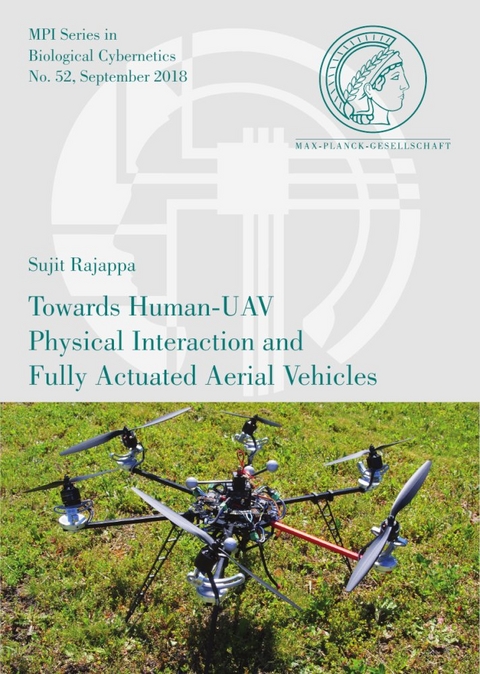
Towards Human-UAV Physical Interaction and Fully Actuated Aerial Vehicles
Seiten
2018
Logos Berlin (Verlag)
978-3-8325-4767-7 (ISBN)
Logos Berlin (Verlag)
978-3-8325-4767-7 (ISBN)
Unmanned Aerial Vehicles’ (UAVs) ability to reach places not accessible to humans or
other robots and execute tasks makes them unique and is gaining a lot of research
interest recently. Initially UAVs were used as surveying and data collection systems,
but lately UAVs are also efficiently employed in aerial manipulation and interaction
tasks. In recent times, UAV interaction with the environment has become a common
scenario, where manipulators are mounted on top of such systems. Current
applications has driven towards the direction of UAVs and humans coexisting and
sharing the same workspace, leading to the emerging futuristic domain of Human-UAV
physical interaction.
The research in this thesis initially addresses the delicate problem of external wrench
(force/torque) estimation in aerial vehicles which is executable during flight without any
additional sensors. Thereafter a novel architecture is proposed, allowing humans to
physically interact with a UAV through the employment of sensor-ring structure and the
developed external wrench estimator. The methodologies and algorithms to distinguish
forces and torques derived by physical interaction with a human from the disturbance
wrenches (due to e.g., wind) are defined through an optimization problem.
Furthermore, an admittance-impedance control strategy is employed to act on them
differently.
This new hardware/software architecture allows for the safe human-UAV physical
interaction through exchange of forces. But at the same time, other limitations such as
the inability to exchange torques due to the underactuation of quadrotors and the need
for a robust controller become evident. In order to improve the robust performance of
the UAV, an adaptive super twisting sliding mode controller that works efficiently
against parameter uncertainties, unknown dynamics and external perturbations is
implemented. In addition, a novel fully actuated tilted propeller hexarotor UAV is
designed along with the exact feedback linearization controller and the tilt angles are
optimized in order to minimize power consumption, thereby improving the flight time.
This fully actuated hexarotor could reorient while hovering and perform 6DoF (Degrees
of Freedom) trajectory tracking.
Eventually, the external wrench observer, interaction techniques, hardware design,
software framework, the robust controller and the different methodologies are put
together into the development of Human-UAV physical interaction with fully actuated
Hexarotor UAV. This framework allows humans and UAVs to exchange forces as well
as torques, becoming the next generation platform for the aerial manipulation and
human physical interaction with UAVs.
other robots and execute tasks makes them unique and is gaining a lot of research
interest recently. Initially UAVs were used as surveying and data collection systems,
but lately UAVs are also efficiently employed in aerial manipulation and interaction
tasks. In recent times, UAV interaction with the environment has become a common
scenario, where manipulators are mounted on top of such systems. Current
applications has driven towards the direction of UAVs and humans coexisting and
sharing the same workspace, leading to the emerging futuristic domain of Human-UAV
physical interaction.
The research in this thesis initially addresses the delicate problem of external wrench
(force/torque) estimation in aerial vehicles which is executable during flight without any
additional sensors. Thereafter a novel architecture is proposed, allowing humans to
physically interact with a UAV through the employment of sensor-ring structure and the
developed external wrench estimator. The methodologies and algorithms to distinguish
forces and torques derived by physical interaction with a human from the disturbance
wrenches (due to e.g., wind) are defined through an optimization problem.
Furthermore, an admittance-impedance control strategy is employed to act on them
differently.
This new hardware/software architecture allows for the safe human-UAV physical
interaction through exchange of forces. But at the same time, other limitations such as
the inability to exchange torques due to the underactuation of quadrotors and the need
for a robust controller become evident. In order to improve the robust performance of
the UAV, an adaptive super twisting sliding mode controller that works efficiently
against parameter uncertainties, unknown dynamics and external perturbations is
implemented. In addition, a novel fully actuated tilted propeller hexarotor UAV is
designed along with the exact feedback linearization controller and the tilt angles are
optimized in order to minimize power consumption, thereby improving the flight time.
This fully actuated hexarotor could reorient while hovering and perform 6DoF (Degrees
of Freedom) trajectory tracking.
Eventually, the external wrench observer, interaction techniques, hardware design,
software framework, the robust controller and the different methodologies are put
together into the development of Human-UAV physical interaction with fully actuated
Hexarotor UAV. This framework allows humans and UAVs to exchange forces as well
as torques, becoming the next generation platform for the aerial manipulation and
human physical interaction with UAVs.
| Erscheinungsdatum | 20.11.2018 |
|---|---|
| Reihe/Serie | MPI Series in Biological Cybernetics ; 52 |
| Sprache | englisch |
| Maße | 145 x 210 mm |
| Einbandart | Paperback |
| Themenwelt | Informatik ► Theorie / Studium ► Künstliche Intelligenz / Robotik |
| Naturwissenschaften ► Chemie ► Organische Chemie | |
| Technik ► Luft- / Raumfahrttechnik | |
| Schlagworte | Aerial Robotics • automatic control engineering • Computer Science • human robot interaction • Unmanned Aerial Vehicles (UAVs) |
| ISBN-10 | 3-8325-4767-3 / 3832547673 |
| ISBN-13 | 978-3-8325-4767-7 / 9783832547677 |
| Zustand | Neuware |
| Haben Sie eine Frage zum Produkt? |
Mehr entdecken
aus dem Bereich
aus dem Bereich
Buch | Softcover (2024)
REDLINE (Verlag)
20,00 €
Eine kurze Geschichte der Informationsnetzwerke von der Steinzeit bis …
Buch | Hardcover (2024)
Penguin (Verlag)
28,00 €


